Award of Excellence
SHIFT:infrastructure
Lorna Allen, Student Associate ASLA; Tucker Beeninga, Student ASLA; Sarah Elsaesser, Associate ASLA; Matt Evans, Student ASLA; Benjamin Hood, Student ASLA; Michael Lynskey, Associate ASLA; Preston Montague, Student ASLA; Leslie Morefield, Associate ASLA; Lindsay Ruderman, Student ASLA; Scott Simmons, Associate ASLA; Caitlin Smolewski, Associate ASLA;
Matt Tomasulo, Student ASLA; David Toms, Associate ASLA and Luke Wallenbeck, Associate ASLA, Graduate-Undergraduate, North Carolina State University
Faculty Advisor: Andrew Fox, ASLA
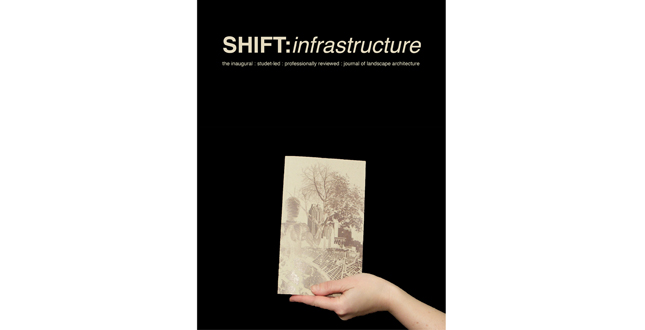 Close Me!
Close Me!the inaugural : student led : professionally reviewed : journal of landscape architecture
Download Hi-Res ImageImage: Student Team
Image 1 of 13
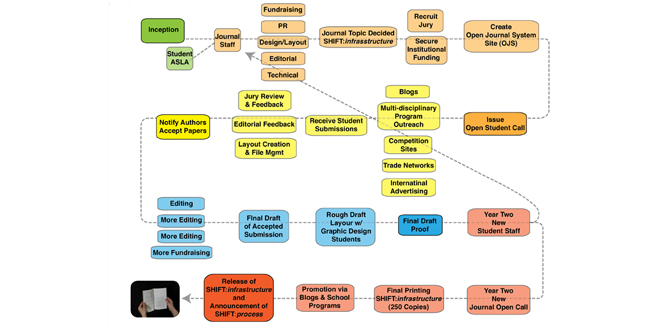
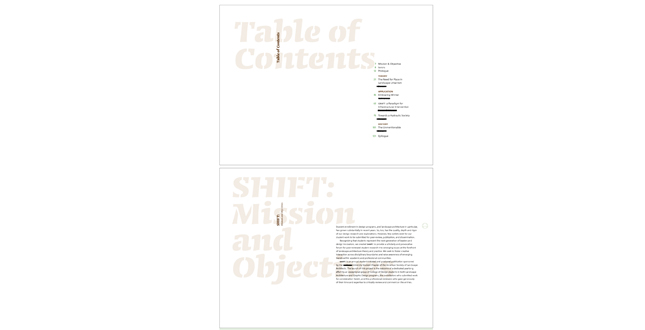 Close Me!
Close Me!SHIFT:infrastructure addresses infrastructure from three angels, theory, application, and history. It offers a new venue for student publication and an innovative learning model for the design classroom.
Download Hi-Res ImageImage: Student Team
Image 3 of 13
 Close Me!
Close Me!A jury of highly respected practitioners and established academics were recruited to review student submissions. It sets forth a vision of future infrastructures as imagined by current students.
Download Hi-Res ImageImage: Student Team
Image 4 of 13
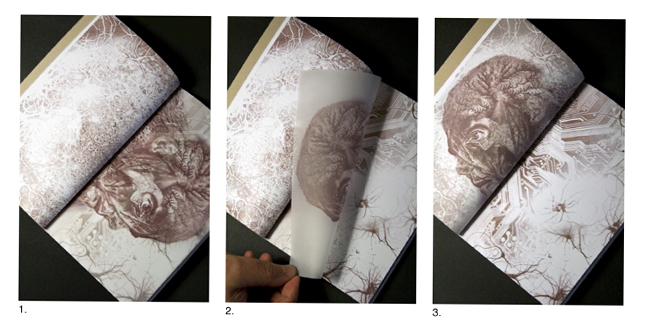 Close Me!
Close Me!Section break artwork symbolizes the transparency called for in next generation infrastructure. It visually merges the organic with the artificial. Page orientation changes here, urging the reader to slow down, reflect, and interact with the journal.
Download Hi-Res ImageImage: Student Team
Image 5 of 13
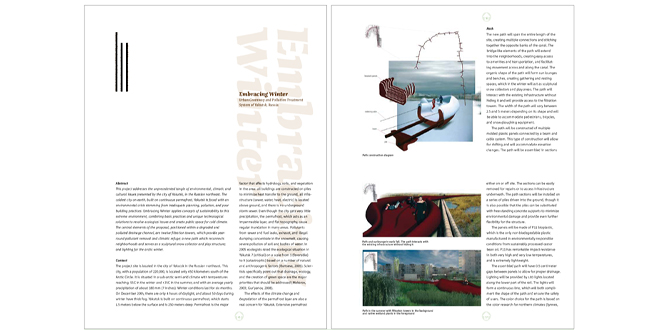 Close Me!
Close Me!"Embracing Winter" describes a design proposal used to build features that both enhance and supplement natural processes while providing cultural amenities that seek to achieve socio-ecological synergy.
Download Hi-Res ImageImage: Student Team
Image 6 of 13
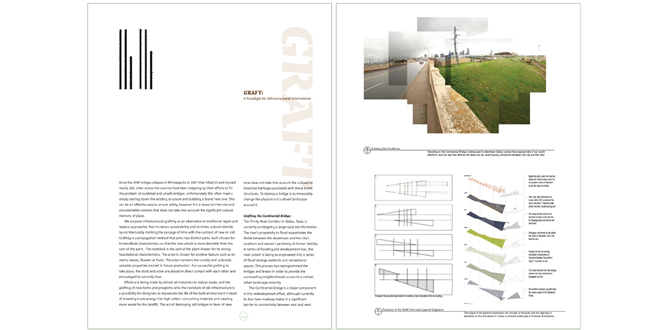 Close Me!
Close Me!"Graft" highlights the evolving nature of infrastructure by introducing the horticultural practice of “grafting.” The authors utilize functional remnants of previous infrastructural elements as “rootstock” on which to fuse, or graft, new design elements.
Download Hi-Res ImageImage: Student Team
Image 7 of 13
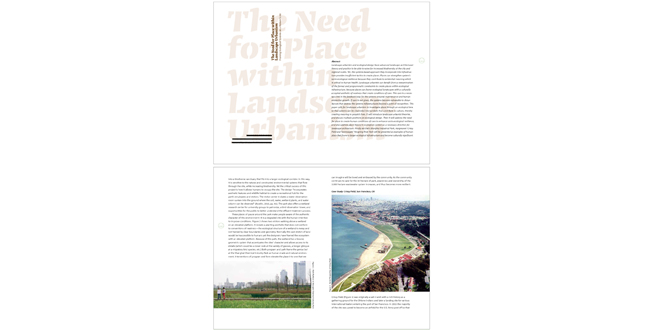 Close Me!
Close Me!"Need for Place" critiques Landscape Urbanist theory and posits the need for functional transparency and cultural ownership of infrastructure solutions.
Download Hi-Res ImageImage: Student Team
Image 8 of 13
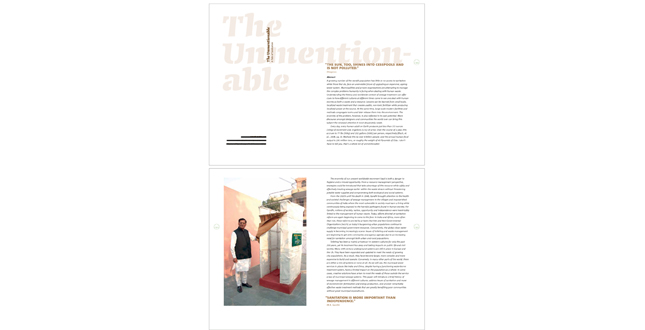 Close Me!
Close Me!"The Unmentionable" introduces the realm of human sanitation as a valuable resource, rather than expensive problem to be flushed away.
Download Hi-Res ImageImage: Student Team
Image 9 of 13
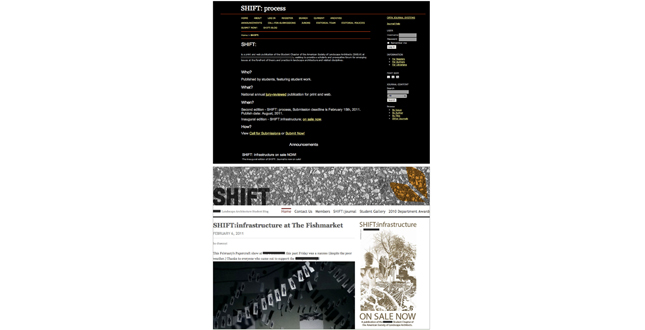 Close Me!
Close Me!Companion websites: "SHIFT:open journal system" manages submissions and 'SHIFT:blog' serves as avenue for daily discussion.
Download Hi-Res ImageImage: Student Team
Image 10 of 13
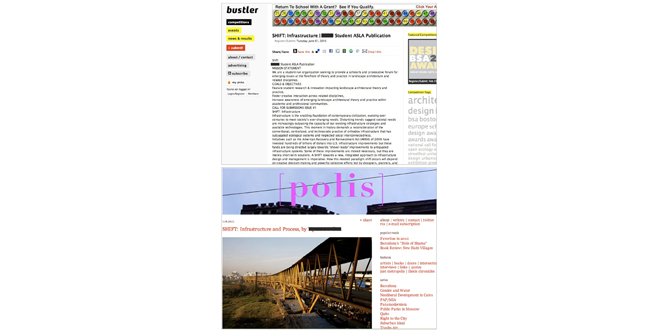 Close Me!
Close Me!Outreach and promotion is pursued via popular academic and trade venues.
Download Hi-Res ImageImage: Student Team
Image 11 of 13
 Close Me!
Close Me!SHIFT:infrastructure continues as a yearly journal. Next issue SHIFT:process…
Download Hi-Res ImageImage: Student Team
Image 12 of 13
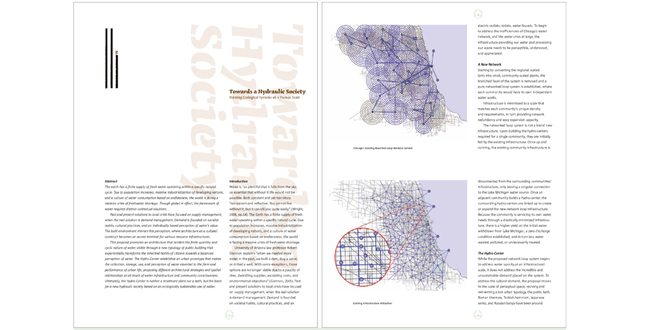 Close Me!
Close Me!"Towards a Hydraulic Society" addresses the importance of cultural awareness in the conception and implementation of design solutions and suggests an architectural approach to solving both functional and societal goals.
Download Hi-Res ImageImage: Student Team
Image 13 of 13
Project Statement
SHIFT:infrastructure is an annual student produced publication sponsored by the North Carolina State University Student Chapter ASLA. Recognizing that students represent the next generation of leaders and design innovators, we created SHIFT: to provide a scholarly and provocative forum for professional-reviewed student research into emerging issues at the forefront of landscape architecture theory and practice. We seek to foster creative interaction across disciplinary boundaries and raise awareness of emerging trends within academic and professional communities.
Project Narrative
—2011 Student Awards Jury
"The one common experience of all humanity is the challenge of problems."
—R. Buckminster Fuller
A light switch, a toilet flush, a trip to the grocery store —each is a symbol of the enabling infrastructure of our modern lifestyle, and yet each is routinely disregarded in the rush of daily life. Despite its immensity and our great investment, the vast infrastructure deployed on, under and above the landscape has effectively become invisible. It seems it is only in moments of catastrophe—a sewage spill, a collapsed bridge, or a failed levy—that we reflect on our dependence upon the increasingly strained and precious landscape infrastructure systems that sustain our survival, function, and quality of life. The belief that infrastructure systems have infinite capacity and the means to accommodate the demands of an expanding resource-hungry society is at issue. Widely published and acknowledged trends suggest that the wants and needs of current and emerging societies for water, electricity, transportation, and other resources have and will increasingly overwhelm many critical infrastructure systems.
As we enter new economic paradigms, traditional development practices must be challenged. Initiatives such as the American Recovery and Reinvestment Act (ARRA) of 2009 have invested hundreds of billions of dollars into U.S. infrastructure improvements but these funds are being directed largely towards "shovel-ready" improvements to antiquated infrastructure systems. Some of these improvements are indeed necessary, but they are merely short-term solutions. A SHIFT towards a new, integrated approach to infrastructure design and management is imperative. How can we leverage this opportunity to invent alternate ideas, strategies and tools that yield infrastructure models resulting in measurably superior and more sustainable conditions with regards to social equity, ecological resiliency and economic prosperity? This is the time for a multi-scalar re-evaluation of the current conventional, centralized, and technocratic systems and approaches that degrade fundamental ecological and social systems and their interdependencies. This is the time for better ideas, values, and solutions.
This publication reveals visions of our future as imagined by a rising generation of student contributors. It provides a glimpse into the values and theories of design that they will define, explore, and test in their professional careers.
Our Call
SHIFT:infrastructure invited our academic peers from around the globe to share their scholarly work to broaden the discourse challenging traditional notions of landscape infrastructure and advocating future directions of landscape architectural practice and inquiry. Following is the "Call for Submittals" that was disseminated to entice passionate students to formally develop and submit their work for peer review and possible publication in this journal.
The Response
The entries we received point to the need for increased understanding and comprehension of landscape infrastructure and its support of the functions that sustain society. Each submission underwent a thorough review process by an external panel of distinguished thinkers and designers that culminated in the selection of five entries for inclusion in this journal. The selected entries look at infrastructure from diverse perspectives and reflect a broad geographical range—from south Texas, to India to the far reaches of Siberia. The authors generally emphasize the need for local, personalized solutions to infrastructure challenges and suggest that the era of centralized infrastructure is shiftingto distributed models that better fit the social and environmental needs of the unique regions, communities, and neighborhoods they support.
The Results
The papers published in our first edition, SHIFT: infrastructure, call for more personal, even spiritual connections between the built and natural systems that support all life. Collectively, these papers represent insightful student investigations into the underlying shortcomings of existing landscape infrastructural systems. Individually, the authors remind us that designs rooted in lessons learned from the past and executed with forward-thought in the present might potentially deliver a more socially rich and ecologically sound future. The authors present a common vision for a future in which landscape architects increasingly engage communities as cogent collaborators seeking to engender a legacy of social and ecological connectivity.
The Impact
In addition to providing a fresh look at the future of infrastructure through the eyes of emerging designers, the initiation of SHIFT:infrastructure as an annual publication has created a powerful learning platform for students. As a purely extracurricular and student run activity, it engenders a strong ethic of teamwork, leadership, and personal responsibility among team members. By reaching far beyond its home institution to recruit jurors and solicit student contributions, it fosters inter-institution and inter-disciplinary dialog and exposes students to multiple perspectives.
As we look forward to the contributions that will shape the next issue, we thank the student authors and professional jurors for their contributions to this journal. We respectfully hope these papers motivate discourse among an interdisciplinary field of designers, planners, and engineers who, ultimately, will invent viable solutions for the design and making of healthier places.
Additional Project Credits
NC State Graphic Design: Graphic Designers
Kelly Bailey
TJ Blanchflower
Chair NC State College of Design, Department of Landscape Architecture
Gene Bressler, FASLA
NC State Student Chapter American Society of Landscape Architecture
Special Thanks to Jordan Petersen






